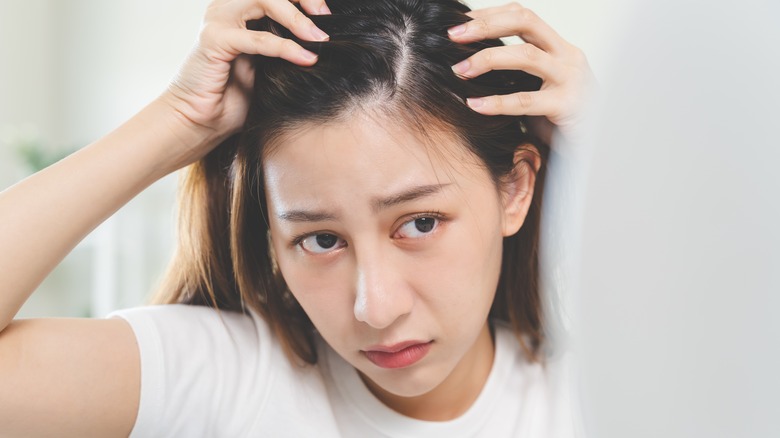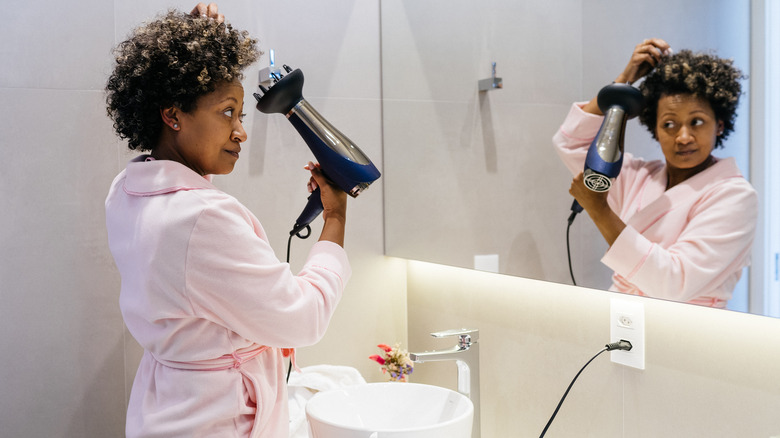Yes, You Can Get Mold And Mildew In Your Hair. Here's How To Ensure That Doesn't Happen
We don't mean to alarm you, but it turns out mold and mildew can actually grow in your hair. But don't panic! While this growth is typically uncommon (and totally preventable) it's a scary thought to imagine it growing in your scalp. The culprit behind this is prolonged moisture on your scalp explained the Mestiza Muse. Your scalp has pores and glands all over it that work to produce sebum: a natural secretion that protects your hair. But because these glands also produce sweat, your scalp is already a naturally moist environment, making extra moisture in this area a potential danger.
This doesn't mean that every time your hair is wet it will start to develop mold, but it does mean you have to be mindful of how you handle your wet strands. Letting your hair stay damp without proper airflow to your scalp can trap moisture over time and develop unsavory microorganisms. Yes, this means going to bed with wet hair can actually cause more harm than good. Those old wives' tales about getting sick from going to sleep with wet hair may have a glimmer of truth to them. Luckily this is an easy problem to navigate, even if you are a nighttime showerer who doesn't want to use heat products.
Signs of mold and mildew in hair
One of the biggest telltale signs you may be dealing with a mold problem is the familiar smell that accompanies it. If you start to notice a wet, mildew smell coming from your pillowcase or your hair, you may want to visit a dermatologist and see what's going on with your scalp. Another common sign is an uptick of dandruff, especially if you are someone who typically doesn't have it.
Dandruff from excess moisture will be yellowish in appearance and tends to flake off the scalp in larger chunks. There is actually a name for this type of dandruff, appropriately named "wet dandruff" according to StyleCraze. Wet dandruff results from excess moisture on the scalp from overproducing sebaceous glands. When your scalp is wet it can create an overproduction of sebum (which mold likes to feed on) that gets stuck on the dead skin cells of your scalp. This causes wet, sticky clumps of dandruff. No thank you! Sleeping with wet hair can cause more hair health problems than you realize, so it's best to avoid it when possible.
Make sure your sleep setup is sanitary
One of the easiest steps to avoid this problem is not sleeping with wet hair. But if you prefer to shower at night, having wet hair at bedtime can feel unavoidable. If you're comfortable with it, using a blow dryer on a cool setting can help speed up the drying process. Direct this at your scalp to ensure your roots are dry. You can also aim to shower earlier in the night to give yourself more time. Drying your scalp with a microfiber towel post-shower as best you can is a heat-free alternative too. You don't have to get your hair completely dry, just make sure it's not soaking wet and that your scalp is relatively dry. While you wait for your hair to dry, you can try some heatless curl hacks, giving you extra time and styled hair.
Another easy way you can help prevent the growth of mold and mildew is to keep your pillows and sheets clean. Aim to wash your sheets once a week to keep them as sanitary as possible. You may also want to consider making the switch to a silk pillowcase. These pillowcases are antibacterial on a micro level and offer a breathable material for your skin and hair. Make sure you replace your pillows every one to two years to ensure they also stay fresh and free of allergens and mold.


